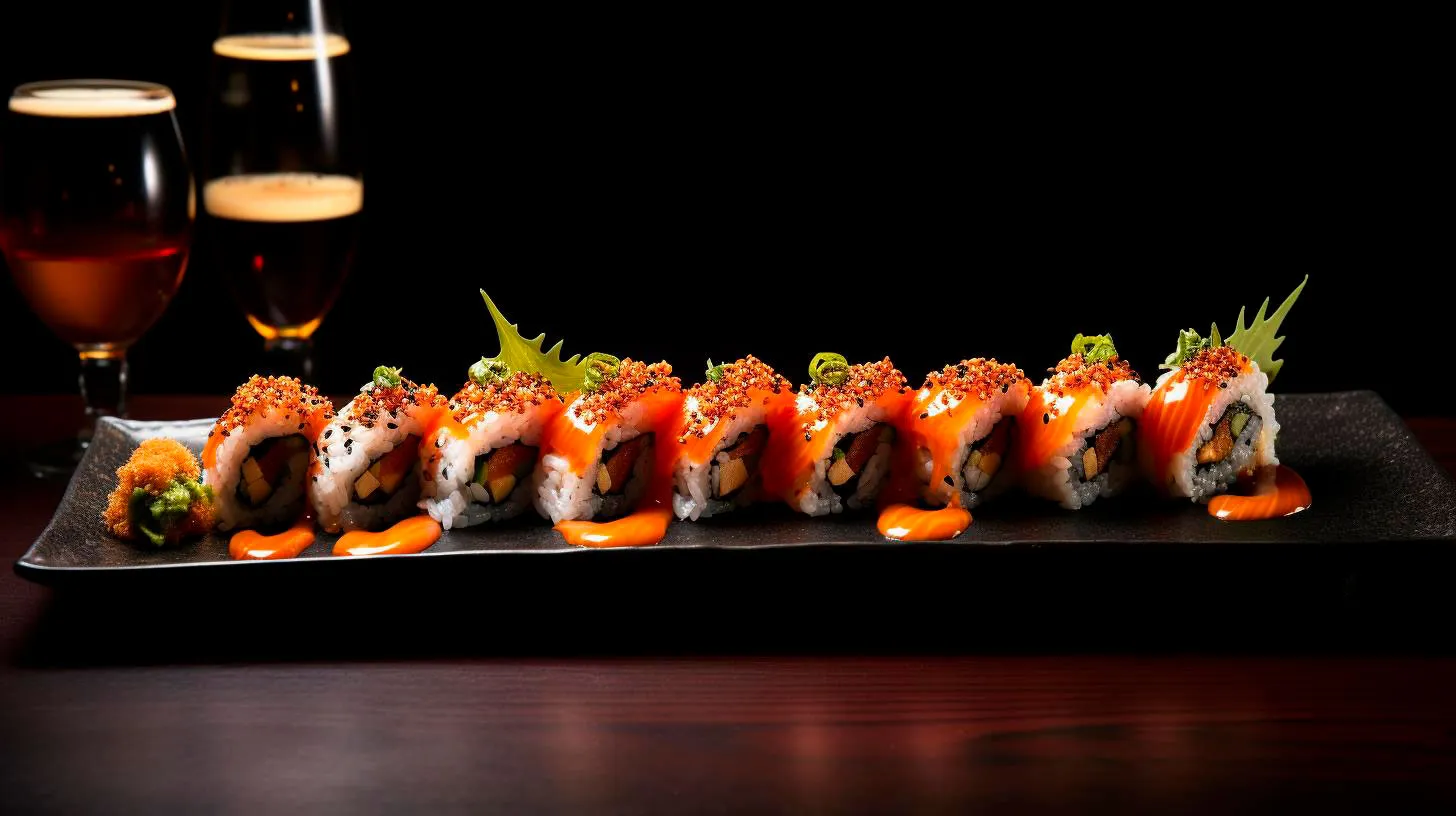4 Essential Food Safety Protocols for Sushi Staff Training
Therefore, proper training and implementation of food safety protocols are crucial for sushi staff. In this blog post, we will delve into four essential food safety protocols that should be a cornerstone of sushi staff training.
1. Understanding the Importance of Personal Hygiene
First and foremost, sushi staff must be aware of the significance of personal hygiene in maintaining food safety. One small oversight in personal hygiene can lead to severe consequences in terms of customer health and even reputation of the sushi establishment. Here are vital personal hygiene practices that sushi staff must adopt:
- Regular handwashing: Sushi staff should wash their hands thoroughly and frequently using warm water and soap for at least 20 seconds. This is particularly important before handling any sushi ingredients or equipment.
- Wearing clean uniforms: Clean uniforms, including aprons and head coverings, must be worn by sushi staff to minimize the risk of bacterial contamination.
- Avoiding illnesses: Sushi staff with any symptoms of illness, such as diarrhea, vomiting, or respiratory illnesses, should be instructed not to handle sushi ingredients or work in any areas where food is prepared or served.
Key Takeaway: Personal hygiene practices, such as proper handwashing and wearing clean uniforms, are essential to prevent the transfer of harmful bacteria and maintain food safety in sushi preparation.
2. Ensuring Proper Fish and Ingredient Handling
The freshness and quality of fish and ingredients used in sushi play a pivotal role in delivering a safe and delightful dining experience. Here are some protocols sushi staff should follow to ensure proper fish and ingredient handling:
- Receiving and storage: Sushi staff should inspect fish deliveries, checking for any signs of spoilage, such as off odors or sliminess. Additionally, proper storage practices, like maintaining appropriate temperature and using first-in, first-out (FIFO) inventory rotation, should be followed to prevent cross-contamination and reduce the risk of foodborne illnesses.
- Fish preparation: Thoroughly trained sushi staff should have the knowledge and skills to properly fillet fish, removing all bones and ensuring it is free from any parasites or signs of spoilage.
- Ingredient freshness: Beyond fish, sushi staff should also pay attention to the freshness of other ingredients like vegetables, rice, and seaweed. Ensuring proper storage, temperature control, and rotating stock are crucial in maintaining ingredient freshness.
Key Takeaway: Adhering to proper fish and ingredient handling protocols helps maintain freshness, minimize the risk of foodborne illnesses, and ensure an exceptional sushi experience.
3. Implementing Cross-Contamination Prevention Techniques
Cross-contamination is a significant concern when it comes to sushi preparation. The risk of cross-contamination arises from the transfer of harmful bacteria between different ingredients or surfaces. To avoid this, sushi staff should implement the following protocols:
- Separate workstations: Different workstations should be designated for the handling of raw and cooked ingredients to avoid cross-contamination. Additionally, separate utensils and cutting boards should be used for different types of ingredients.
- Proper cleaning and sanitizing: Regular cleaning and sanitizing of utensils, equipment, and work surfaces is paramount to prevent the growth and spread of bacteria.
- Frequent glove changes: Sushi staff should change gloves between handling different ingredients to prevent cross-contamination.
Key Takeaway: Implementing cross-contamination prevention techniques helps maintain the integrity of ingredients, prevents foodborne illnesses, and ensures the safety of sushi enthusiasts.
4. Understanding Temperature Control in Sushi Preparation
Sushi ingredients, particularly raw fish, are highly perishable and must be stored and served at the appropriate temperatures. Sushi staff must understand the importance of temperature control and follow these protocols:
- Storage temperature: Sushi ingredients should be stored at proper temperatures to prevent bacterial growth. Cold storage should be maintained at or below 41°F (5°C) and hot storage above 140°F (60°C).
- Serving temperature: Sushi should be prepared and served at the right temperature to maintain freshness and flavor. For example, sushi rice should be served slightly warm or at room temperature.
- Regular temperature checks: Sushi staff should regularly monitor storage and display temperatures using calibrated thermometers to ensure food safety.
Key Takeaway: Strict temperature control practices aid in preventing bacterial growth, maintaining ingredient quality, and ensuring sushi enthusiasts have a safe and enjoyable dining experience.
Conclusion
Proper food safety protocols are indispensable when it comes to sushi staff training. By emphasizing personal hygiene, proper fish and ingredient handling, cross-contamination prevention, and temperature control, sushi establishments can ensure the highest level of food safety. Following these protocols will not only safeguard customer health but also enhance the reputation and success of sushi businesses in an industry where food safety is paramount.
Increasing Awareness and Knowledge: Training Sushi Staff on Food Safety Measures
Training sushi staff on food safety not only enhances the dining experience for customers but also reduces the risk of foodborne illnesses and maintains a positive reputation for the restaurant. In this blog article, we will explore the importance of providing food safety training to sushi staff and highlight key measures that should be implemented.
1. The Importance of Food Safety Training for Sushi Staff
Safe food handling practices are essential to prevent the transmission of harmful bacteria and viruses. When sushi staff undergo rigorous food safety training, they gain the necessary knowledge and skills to maintain hygienic practices throughout the entire sushi preparation process. Here are some key reasons why training sushi staff on food safety is crucial:
- Preventing Foodborne Illnesses: Proper food safety measures significantly reduce the risk of foodborne illnesses, such as salmonella or norovirus, which can have severe consequences for both customers and the reputation of the sushi restaurant.
- Compliance with Regulations: Many countries have stringent food safety regulations that restaurants must adhere to. Training sushi staff ensures compliance with these regulations, avoiding penalties or legal issues.
- Enhancing Customer Satisfaction: When customers dine at a sushi restaurant, they expect their food to be safe and of high quality. Proper training helps staff maintain the highest possible standards, ensuring customer satisfaction and loyalty.
2. Key Measures for Food Safety Training
Training sushi staff on food safety should be a comprehensive process covering various aspects of safe food handling. Here are some essential measures to include in the training program:
2.1. Ingredient Selection and Handling
Choosing high-quality ingredients and ensuring their safe handling is crucial for food safety. Sushi staff should be trained on:
- Inspecting and selecting fresh fish and other ingredients
- Proper storage and temperature control
- Preventing cross-contamination
2.2. Personal Hygiene and Sanitation
Sushi staff must maintain excellent personal hygiene practices to prevent the spread of contaminants. Training should cover:
- Proper handwashing techniques
- Wearing clean and appropriate attire, including gloves and hairnets
- Regular sanitization of work surfaces and equipment
2.3. Safe Sushi Preparation Techniques
The proper techniques used in sushi preparation play a vital role in food safety. Training should focus on:
- Proper rice cooking and seasoning
- Correct knife handling and cutting techniques
- Hygienic handling of raw and cooked ingredients
2.4. Temperature Control and Storage
Temperature control is paramount in preventing the growth of bacteria that can cause foodborne illnesses. Training should include:
- Understanding temperature danger zones
- Utilizing refrigeration and freezing techniques effectively
- Regular monitoring and recording of storage temperatures
3. Benefits of Training Sushi Staff on Food Safety Measures
Providing food safety training to sushi staff offers numerous benefits to both the restaurant and its customers. Here are some key advantages:
- Reduced Risk of Food Contamination: Proper training significantly minimizes the chances of contamination, ensuring the safety of the food served.
- Enhanced Reputation: By prioritizing food safety, the sushi restaurant establishes a reputation for maintaining high standards, attracting more customers and increasing loyalty among existing ones.
- Fulfilling Legal Requirements: Compliance with food safety regulations safeguards the restaurant from legal troubles and potential fines.
- Improved Employee Morale and Confidence: Training empowers sushi staff, boosting their confidence in handling food safely and fostering a positive work environment.
It is important to remember that food safety training should be an ongoing process. Regularly refreshing knowledge and updating techniques according to industry standards ensures a consistent adherence to food safety practices. By investing in comprehensive food safety training, sushi restaurants can not only protect their customers but also promote a culture of excellence and set themselves apart from competitors in this thriving industry.
Effective Strategies to Ensure Sushi Staff Adhere to Food Safety Guidelines
Establishing effective strategies to promote compliance with food safety guidelines is of utmost importance. In this article, we will discuss some key strategies that sushi establishments can adopt to enhance food safety practices among their staff.
1. Comprehensive Training Programs
One of the most effective ways to ensure staff adhere to food safety guidelines is by implementing comprehensive training programs. These programs should cover all aspects of sushi preparation, including proper handling and storage of ingredients, use of sterile utensils, and maintaining a clean work environment. By providing thorough training, staff members will have a clear understanding of the importance of food safety and the specific measures they need to follow.
- Training programs should include demonstrations and hands-on practice to reinforce proper food safety techniques.
- Regular refresher courses should be conducted to keep staff updated on any new guidelines or best practices.
- Documentation of training sessions and individual employee certifications should be kept for record-keeping purposes.
2. Clear Standard Operating Procedures (SOPs)
Having well-defined Standard Operating Procedures (SOPs) is essential for maintaining consistency and minimizing errors in sushi preparation. SOPs provide step-by-step instructions on how to handle each ingredient, use specific equipment, and implement necessary safety measures. By developing clear and detailed SOPs, sushi establishments can ensure that all staff members follow the same procedures, reducing the risk of cross-contamination and other food safety issues.
- SOPs should clearly outline the appropriate temperature ranges for different ingredients and storage areas.
- Specific guidelines on personal hygiene, such as handwashing and glove usage, should be included in the SOPs.
- Regular reviews and updates of SOPs should be conducted to incorporate any changes in regulations or processes.
3. Regular Inspections and Audits
To maintain a high level of food safety, regular inspections and audits should be carried out. These inspections can be conducted internally or by hiring external food safety auditors. Inspections help identify any potential issues or deviations from established protocols, enabling timely corrective actions to be taken. It is essential to create a culture of accountability where staff members understand the significance of adherence to food safety guidelines.
- Inspections should cover all areas of the sushi establishment, including the kitchen, storage areas, and dining spaces.
- Audits should be conducted based on recognized food safety standards, such as those set by the Food and Drug Administration (FDA) or local health authorities.
- Regular mock drills or practice sessions can be organized to ensure staff members are prepared to handle food safety emergencies.
4. Utilize Technology for Monitoring
With advancements in technology, sushi establishments can leverage various tools and software to enhance food safety monitoring. For instance, electronic temperature monitoring systems can be used to maintain optimal storage conditions for ingredients. Additionally, digital checklists and documentation can streamline the recording of food safety procedures, facilitating easier tracking and analysis of compliance.
- Implementing real-time monitoring systems can provide instant alerts for temperature fluctuations or other potential risks.
- Digital platforms can enable efficient communication between staff members and management regarding any food safety concerns or updates.
- Data analytics can be utilized to identify patterns or trends in food safety compliance, helping in identifying areas that require improvement.
Conclusion
Ensuring strict adherence to food safety guidelines is vital for the success and reputation of sushi establishments. By implementing comprehensive training programs, clear SOPs, regular inspections, and utilizing technology for monitoring, sushi staff can maintain the highest standards of food safety. These strategies not only reduce the risk of foodborne illnesses but also contribute to the overall quality and satisfaction of customers. Prioritizing food safety ultimately leads to a stronger and more successful sushi business.
How to Train Sushi Staff on Regulatory Compliance and Food Safety Standards
In this article, we will explore effective strategies to train sushi staff on regulatory compliance and food safety standards that will help your sushi restaurant stand out from the competition.
The Importance of Regulatory Compliance and Food Safety Standards in Sushi Restaurants
Before delving into the training strategies, let’s understand why regulatory compliance and food safety standards are vital for sushi restaurants:
- Consumer Safety: strict adherence to food safety regulations ensures the well-being of customers, reducing the risk of foodborne illnesses and allergic reactions.
- Reputation and Trust: Maintaining high food safety standards builds trust among customers, leading to repeat business and positive online reviews.
- Legal Compliance: Failure to comply with regulatory requirements can result in severe penalties, including fines, closure, or even legal actions against the establishment.
Training Strategies for Sushi Staff
Now that we understand the importance of regulatory compliance and food safety standards, let’s explore some effective training strategies:
1. Establish Clear Standard Operating Procedures (SOPs)
Develop comprehensive SOPs covering all essential aspects of sushi preparation, including hygiene, ingredient sourcing, storage, handling, and cross-contamination prevention. SOPs should be clear, concise, and easily accessible for staff members to refer to regularly.
2. Provide Thorough Training Materials
Create engaging training materials such as manuals, videos, and presentations that cover all food safety regulations and best practices. Ensure these training materials are regularly updated to stay in line with changing regulations and industry standards.
3. Hands-On Training Sessions
Host regular hands-on training sessions to reinforce theoretical knowledge. These sessions can include activities like proper knife handling techniques, sushi rolling, and proper sanitation practices. Encourage staff to ask questions and provide feedback to ensure they grasp the concepts effectively.
4. Conduct Regular Staff Meetings
Organize regular staff meetings to discuss any updates or changes to food safety standards. These meetings are an excellent opportunity to reinforce training, address any concerns or questions, and create a culture of continuous improvement in your sushi restaurant.
5. Assess and Certify Staff
Regularly assess staff members’ understanding of food safety standards through quizzes, practical exams, and certifications. Recognize and reward employees who consistently demonstrate a thorough understanding and adherence to these standards.
Key Takeaways
Here are the key takeaways to ensure your sushi staff is well-trained on regulatory compliance and food safety standards:
- Establish clear SOPs to guide staff in adhering to food safety regulations.
- Provide comprehensive training materials that are regularly updated.
- Host hands-on training sessions to reinforce theoretical knowledge.
- Conduct regular staff meetings to address updates or changes to standards.
- Assess and certify staff to recognize their understanding and adherence.
By implementing these training strategies, your sushi restaurant will not only ensure compliance with regulatory standards but also gain a competitive advantage in the market. Investing in the training and development of your staff will contribute to the overall success and reputation of your sushi business.


